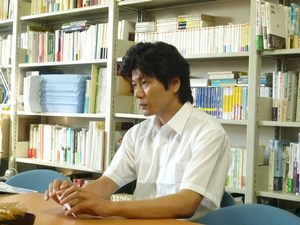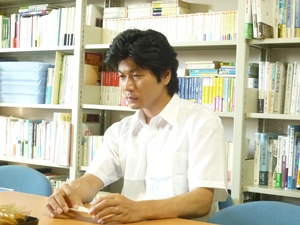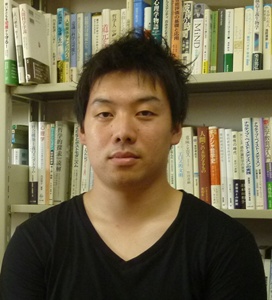I just want to help the people I love

“I just want to help the people I love”
A desire to help, and the miracle it led to
Several months after the 3.11 Great Earthquake, there were problems with relief supplies sent to government offices not being efficiently delivered to those in need. It was in this situation that “Fumbarou East Japan” (“Project Fumbaro Eastern Japan”) representative, Takeo Saijo, came up with a simple system of directly sending supplies to these people. Mr. Saijo, then spread the word of this method to tens of thousands of people over Twitter, starting a revolution in the delivery of relief supplies. Eitarou Konno (Lakeland University, Japan Campus) and Yiru Guo(Sophia University) spoke with one of the most relied-upon people in the disaster area.
(Konno) My hometown is Ishinomaki City, and I volunteered there for a month and a half, clearing up rubble. However, because the local leader was absent, we had a difficult time. What was your strongest feeling during your work in the disaster zone?
(Saijo) This disaster is of a magnitude no-one has ever experienced before. I don’t want to simply say “you can’t understand unless you go,” but the damage was far worse than I imagined – I was lost for words. I also lost an uncle I loved very much, and my relatives and friends that remained have suffered a lot. Even if you go and help out in the disaster zone, it’s very hard to tell the people there to “give it their all.” Everyone is already giving it their best suppressing their unhappiness. Despite the heat, there are people even now in the evacuation sites without fans. There’s still so much more we need to do.
(Konno) What is the reason Ganbarou Higashi Nippon’s work reached so many people in such a short time?
(Saijo) I think it’s because it is based on my research in “Structural Constructivism,” where you grasp the situation on the ground, and try to conduct support activities in as simple a way as possible. There were already a matching website for sending support material, but the people in the disaster area who can access the internet and obtain information are in the minority. We went directly to the evacuees, asked them what they needed, and then put that list up on our website.
Luckily courier services were already running, and through the website we were able to connect people receiving and sending supplies. Before long we went from simply “sending supplies,” to a feeling of “helping specific individuals to receive supplies,” and I think senders motivation to support them became stronger. Twitter was really helpful in relaying the situation from the ground. The will to help those in the disaster zone spread with the dissemination of this vivid information, and friends of “Ganbarou” increased in no time. Also, even if some things went bad and were criticised, if this remained at only around five percent of everything we were doing, we turned a blind eye to it and proceeded with our plans. I think it was good that we stuck to our idea of “only for the disaster people.”
(Guo) How do you think students should respond to the earthquake?
(Saijo) In any event, myself and the students around me want other students to go the disaster zone and see it for themselves. I think it would be difficult for some young people, who are blessed with the environment they have, to empathise with people’s pain and deep sadness. However, for those who go and see the disaster zone, their feelings towards giving support changes in a definite way. As they volunteer, I think the feeling that they want to help others becomes aroused from the bottom of their hearts. I don’t think of the activities that I do as volunteering. I simply act with the thought that in any event I want to help those in the disaster zone – it’s as natural as eating. I think a lot of my fellow workers are the same.
It’s already been four months since the earthquake, but the disaster zone is still far from recovery – everyone’s continued support is needed. Emergency groups such as “Geiger Counter Project” and “Kaden (home applicance) Project”, as well as new groups like Entertainment Squad and Student Squad have started their activities. I think studying for job-hunting is important, but through Ganbarou East Japan’s activities I want everyone to have encounters and experiences that they can’t learn at school – one’s they won’t forget for the rest of their lives.
Takeo Saijo profile:
Waseda University Graduate School (MBA) full-time lecturer. Specialises in Psychology and (Scientific) Philosophy. Systemized the meta-theory “Structural Constructivism”. Originally from Sendai, he started Ganbarou East Japan in order to do what he could for those who lost their lives.
http://plaza.rakuten.co.jp/saijotakeo0725/
http://sites.google.com/site/structuralconstructivism/
twitterID:@saijotakeo (follower:17,532)
Eitarou Konno’s impressions
I was very impressed by Mr Saijo’s words, “I’ve never thought of what I am doing as volunteering.” Having had these feelings myself, people often tell me to “give it my best” or that I’m very “admirable,” but helping your friends and relatives when they are suffering is a natural reaction. Rather, when I think of my friends who lost their lives, I truly feel sorry for not being able to do anything for them - I recognized this again during the interview.
(please see the full article at yokosojapan.net)
translated by Lance Truong (Monash Univ.)
「ふんばろう東日本支援プロジェクト」 http://fumbaro.org/








